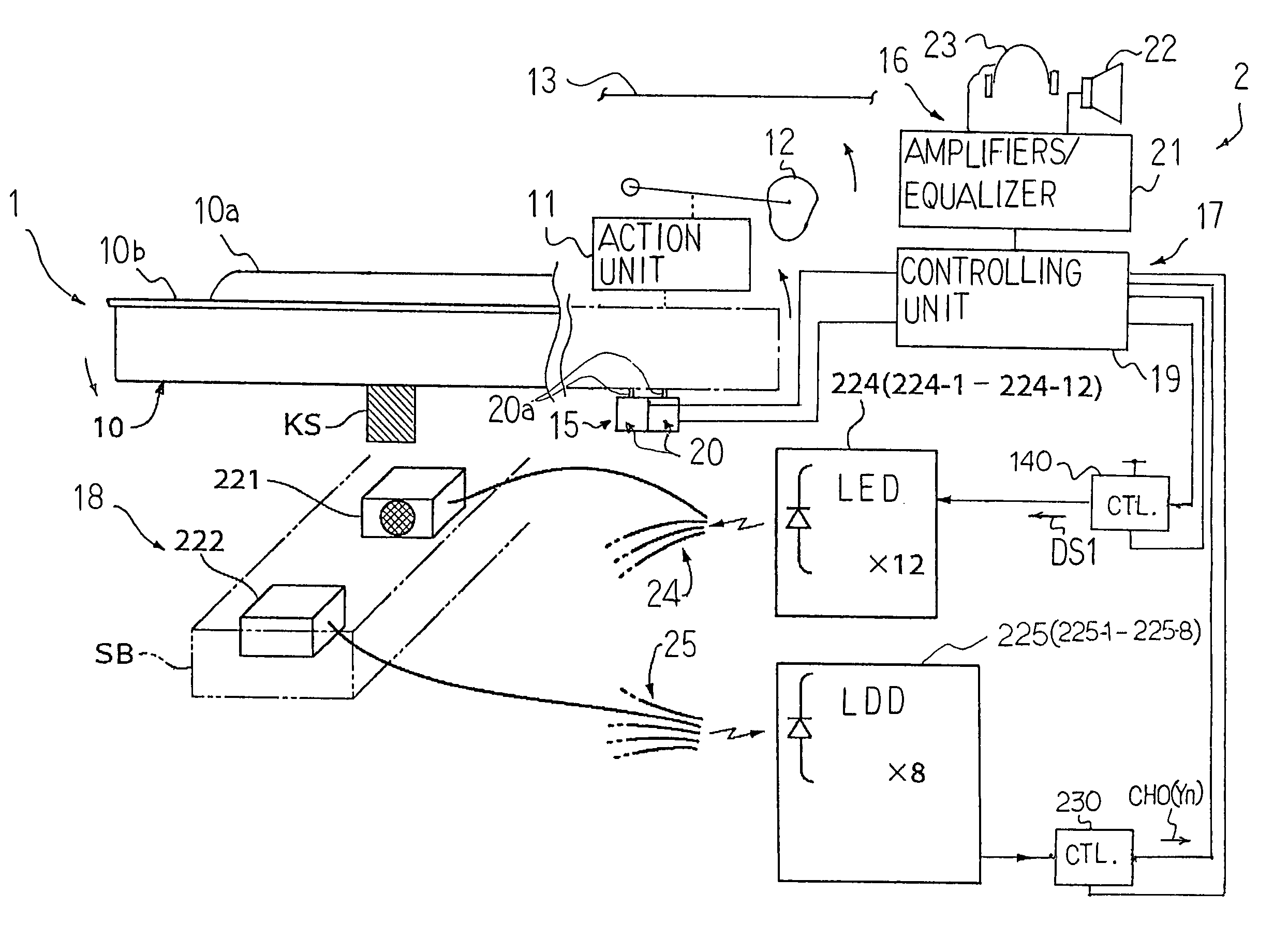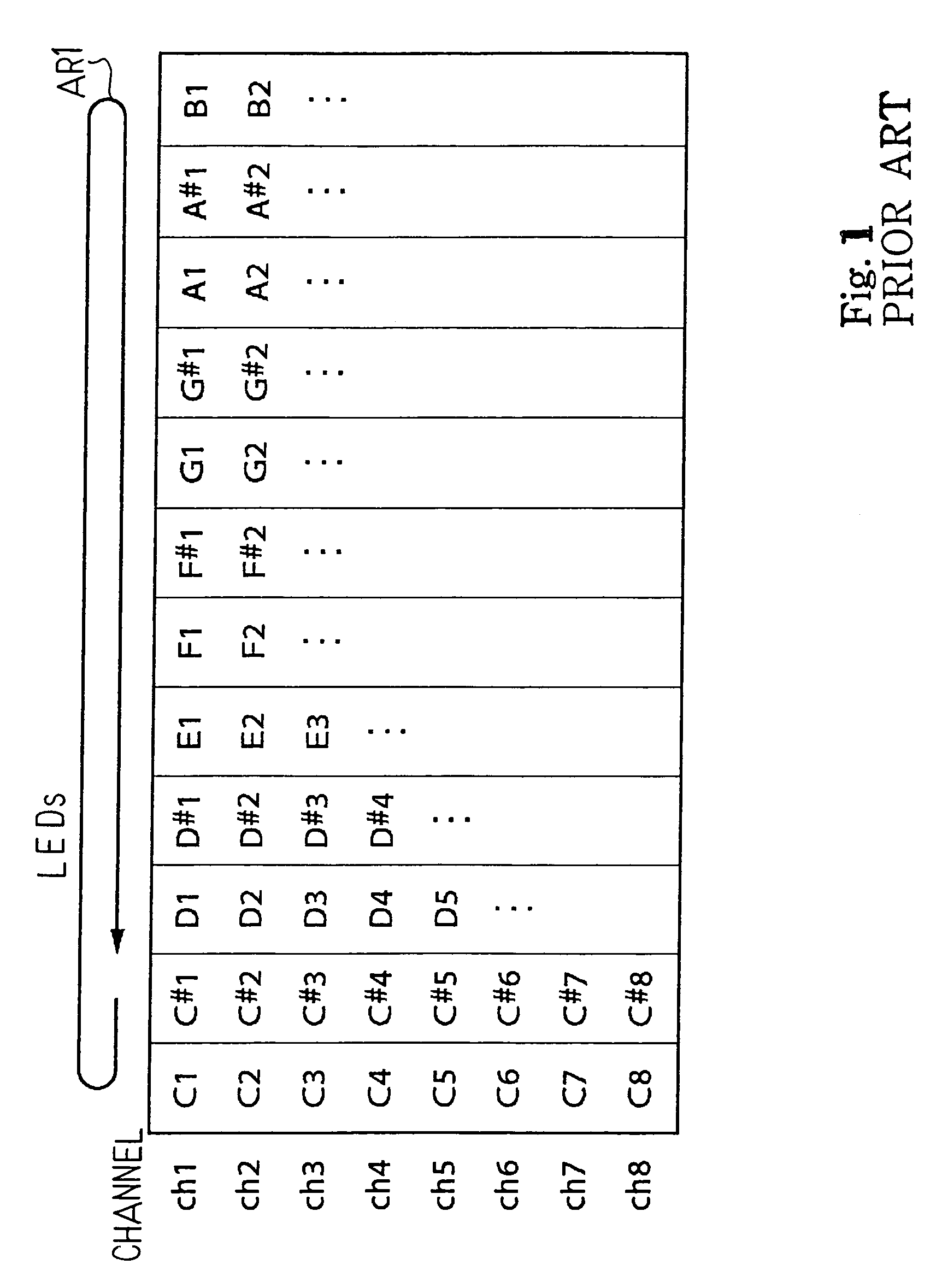Optical transducer system having light emitting elements and light detecting elements both regulable in output characteristics
a technology of optical transducer and output characteristics, which is applied in the direction of optical radiation measurement, instruments, electrophonic musical instruments, etc., can solve the problems of detecting elements still introduced irregularities and age deterioration into detecting signals
- Summary
- Abstract
- Description
- Claims
- Application Information
AI Technical Summary
Benefits of technology
Problems solved by technology
Method used
Image
Examples
first embodiment
[0027]Referring to FIG. 2 of the drawings, an automatic player piano embodying the present invention largely comprises an acoustic piano 1 and an electronic system 2. A pianist fingers a piece of music on the acoustic piano 1, and acoustic piano tones are radiated from the acoustic piano 1. The electronic system 2 is installed in the acoustic piano 1, and gives two options to users. When a user instructs the electronic system 2 to perform a piece of music through the acoustic piano tones, the electronic system 2 produces the acoustic piano tones without any fingering of a human pianist. On the other hand, when the user takes the other option, the electronic system 2 produces electronic tones also without any fingering.
[0028]The acoustic piano 1 includes a keyboard 10, action units 11, hammers 12 and strings 13. Black keys 10a and white keys 10b are incorporated in the keyboard 10, and are laid on the well-known pattern. The black and white keys 10a, 10b are linked with the action un...
second embodiment
[0081]FIG. 8 shows another method for optimizing the luminescence led(x) and bias level CHO(y). An automatic player piano implementing the second embodiment is similar to the automatic player piano described as the first embodiment. For this reason, description is focused on a computer program, which expresses the method, and component parts of the automatic player piano are hereinbelow labeled with references same as those designating the corresponding component parts of the above-described automatic player piano.
[0082]When the optical transducer system 18 is powered, the central processing unit 201 starts to initialize the system, and enters a subroutine program for the optimization during the initialization. The central processing unit 201 firstly changes the luminescent control signal CL1 to the bit pattern indicative of the minimum luminescence led(3) and the potential control signal CL3 to the bit pattern indicative of the maximum bias level CHO(0) as by step S701. The lumines...
third embodiment
[0093]FIG. 10 shows another automatic player piano embodying the present invention. The automatic player piano embodying the present invention largely comprises an acoustic piano 1A and an electronic system 2A. The acoustic piano 1A is same as the acoustic piano 1, and component parts are labeled with references designating the corresponding parts of the acoustic piano 1A without detailed description. The electronic system 2A is similar to the electronic system 2 except for an optical transducer system 18A. For this reason, the other system components are labeled with references designating the corresponding system components, and description is focused on the optical transducer system 18A.
[0094]The optical transducer system 18A is only different in system configuration from the optical transducer system 18 in that the current-to-light converters 224 are not assisted with any controller. Only the bias controllers 230-1 to 230-8 are respectively connected between the light-to-current...
PUM
 Login to View More
Login to View More Abstract
Description
Claims
Application Information
 Login to View More
Login to View More - R&D
- Intellectual Property
- Life Sciences
- Materials
- Tech Scout
- Unparalleled Data Quality
- Higher Quality Content
- 60% Fewer Hallucinations
Browse by: Latest US Patents, China's latest patents, Technical Efficacy Thesaurus, Application Domain, Technology Topic, Popular Technical Reports.
© 2025 PatSnap. All rights reserved.Legal|Privacy policy|Modern Slavery Act Transparency Statement|Sitemap|About US| Contact US: help@patsnap.com



